- Home
- Gary Vaynerchuk
Crushing It! EPB Page 11
Crushing It! EPB Read online
Page 11
Sometimes you just have to jump into the pool, even when you’re scared.
As you gather your ideas and put your strategies in motion, set yourself up emotionally to succeed. Find your courage and strengthen your self-esteem until you feel brave enough to make some noise and invite people’s attention. Then show them that you care deeply about keeping it.
Several of the people interviewed for this book said that, while hugely inspiring, Crush It! didn’t actually compel them to change anything about how they were growing their personal brand or running their business, because they couldn’t imagine operating any other way. Caring about quality, value, and the customer experience above and beyond anything else was already working for them. We live in such a fast, casual, cynical world that it can be almost disorienting to customers when they come into contact with someone whose eagerness to help or please bowls them over like an enthusiastic Saint Bernard. Disorienting but also delightful. And addictive. Crush It! merely confirmed what these stellar entrepreneurs already felt deep in their hearts, and it gave them the satisfaction of knowing they were right to follow their instincts.
It’s very Wizard of Oz, actually. Let me get a little Glinda the Good Witch on you: You’ve always had the power to achieve your wildest ambitions. There is literally—literally—no reason why you can’t become an entrepreneur and influencer in 2018. It’s my greatest hope that by the end of this book, you’ll feel a lot like nine-year-old me as I hurled myself into the deep end of the pool and realized, “Oh, I can fucking swim!”
How I’m Crushing It
Mimi Goodwin, Mimi G Style
IG: @mimigstyle
The school of hard knocks is a brutal place to get your formative education. Mimi Goodwin should know. Raised in Chicago by a single mother who worked two full-time jobs to make ends meet, she often spent time at her grandparents’ house, where she was molested at a young age by two male family members. When her mother remarried, Mimi was abused by her stepfather. She would find respite every summer in Puerto Rico, where she went to spend time with her father. Her aunt was a seamstress, and Mimi loved to make clothes for her Barbies while sitting next to her as she sewed ball gowns and wedding dresses. Mimi’s father bought her a sewing machine, and she took it back with her to Chicago, where her mother would buy her fabric. When she was thirteen, Mimi offered to make a dress for her mother to wear to a wedding. The end result was horrible—the dress’s hemline was off and it didn’t fit properly. Mimi’s mother wore it proudly anyway. Mimi was thrilled, and a seed was planted.
Unfortunately, Mimi’s home life became intolerable and she ran away, leaving the sewing machine behind. Seeking year-round warmth, she used money she’d stolen from her mother to buy a train ticket to California, where a friend of hers had moved with his family a month before. “I thought that all of California was Hollywood.” She couldn’t understand the conductor over the loudspeaker. “I remember the conductor saying ‘something, something, California,’ so I got off the train. And it ended up leaving me in Pomona. And I was like, ‘This doesn’t look anything like the movies.’”
For eight or nine months, she lived in a city park, sleeping on a bench or with random people in exchange for money or food. She eventually made her way to her friend’s house and moved in. The friend became a boyfriend. She experienced domestic violence there, too, and right before her sixteenth birthday, she found out she was pregnant. Upon hearing she was going to be a grandmother, Mimi’s mother came to visit and try to mend the rift between them. “She apologized, and I apologized. I think I had a greater understanding for my mom after I became a parent; I found myself in very similar predicaments.”
Eager to give her daughter, Chastidy, a safer living situation, Mimi moved out of the boyfriend’s house but wound up squatting in an abandoned apartment building with no running water. Her mother begged Mimi to let her take the baby until Mimi could get her life together. Reluctantly, she agreed.
Mimi married the first person she could, so she could get a house and bring her daughter home. Again she found herself in an abusive relationship. A second daughter, Lexi, followed in 1998, and Mimi tried to stick it out with her husband, but when Lexi was a few months old, Mimi asked some married friends if she could move in with them. She had a job as a receptionist and soon moved into her own one-bedroom apartment. She was making ends meet, but barely.
There were weeks where we would have a lot of potatoes or a lot of Top Ramen or whatever we could manage at that time. I would come home from work, go right into the bedroom, close the door, and cry. I felt I was drowning in whatever this life was. And the kids would cry, “Mom! Mom! Mom!” and I’d collect myself and go back into the kitchen and make dinner and move on, because that’s just what you do when you’re a mom.
Things started looking up. She found a job working as a receptionist at a 3-D digital media company for a man named Steve, who mentored her and educated her about his business. She got married again (“my healthiest relationship”), had two more children, and took up her old hobby, sewing. Her husband turned the garage into a little sewing room for her.
She’d wear some of her handmade clothes to the office and always get compliments. Her boss, Steve, who was always the first one to scream across the room, “She made that!” would often sit her down to talk about her ambitions and goals. One day, when they were having this conversation and he was asking yet again what she’d like to do besides be a receptionist, she replied, “I think I’d like to be a fashion designer.”
“How much would you need?” he asked. They talked further about what steps she would have to take to make her dream come true, and she went home.
The next day, she found a $30,000 check on her desk.
She started working on a collection and even had a runway show at the Fashion Business Institute in Los Angeles, but she realized soon enough that while she loved designing, she hated the other aspects of the job. Steve didn’t get upset. “You’ll figure it out,” he assured her.
In 2012, she noticed that a lot of people were starting sewing blogs and making commercial patterns and crafts at home. She thought, I can do that, so in March she started her fashion sewing blog, Mimi G Style. At the time, you could find online instructions to make a quilt or an apron, but there was nowhere to go where you could find out how to make the clothes you saw in magazines. “I would take something I had seen on the runway that of course I could not afford, modify it, and create something new.”
One day she made a skirt inspired by a piece she had seen from Oscar de la Renta. She posted it on the blog, and people went nuts, begging her to make one for them. Mimi wasn’t interested in sewing for hire, so she posted instructions on the blog. The requests persisted, however. Finally, around Christmastime, when she was thinking about gifts for her daughters, she thought, What if I just take a couple of orders? So she posted that she would take orders for twenty-four hours. She priced the skirt high, at $198, to keep the number of orders low. And she warned people not to expect to get their skirt for four weeks. Then she went to bed.
When she woke up the next day, she had thousands of dollars’ worth of orders.
She freaked out, sewed nonstop with her daughters cutting and her husband folding next to her, delivered the skirts, and swore, “Never again.” Then she thought, What if I could just teach them to make it themselves?
She filmed a series of video lessons, showing people step-by-step how to create a garment from scratch based on their body measurements. She created one new video per month, and earnings rose so fast that in two years she was able to quit her job and focus on growing her business. Meanwhile, “I was getting all these e-mails from everywhere in the world, from all these women saying, ‘I came across your blog and you inspired me to start a new hobby,’ or ‘You’re inspiring me to dress better,’ or ‘I just lost my job,’ ‘I’m going through a divorce,’ ‘I was thinking of committing suicide,’ or ‘I’m in rehab,’ and then saying things like, ‘Somehow your blog ha
s helped me get through.’ At that moment, I realized that the blog was less about fashion and sewing and really was a vehicle of motivation.”
A friend who loved business books introduced Mimi to Crush It! in 2015. By then, her blog was trucking along, she was developing her own products, and she had started her own line of commercial patterns. She was already using and loving social media, but reading the book showed her that there was still more she could do. “OK, you turned your hobby into your career, it’s your passion, you’re working hard, but now you need to do more. Now you need to engage more. Now you need to crank up your customer service. Now you need to spend time asking all these questions and making sure that those followers and those fans really engage and become loyal to you. You need to keep building that community.”
For example, one day Mimi posted that she was going fabric shopping, and someone wrote that she would be willing to fly all the way from Tampa to go fabric shopping with her. “I thought that was insane, but I moved the date by thirty days, and people came! And at the end of the day, they asked, ‘What are we doing next year?’ Next year?”
The next year, she booked a hotel, set up some classes, and about eighty people showed up. In 2017, the Mimi G Style Fashion Sewing & Style Conference celebrated its sixth anniversary. It’s followed by thousands of people on Facebook, Instagram, and Mimi’s blog.
Mimi has worked with about three hundred different brands by now, but she says the day she got a call from Project Runway was her greatest moment.
They were working on Project Runway Junior, and the kids were going to be using vintage patterns and turning them into a more modern look. They contacted Simplicity [Pattern] because they knew that’s what I used, and asked if I could come on the show and be a mentor to the kids and introduce the challenge with Tim Gunn. And so the folks at Simplicity called me and said, “Hey, Project Runway called. They want you to come do the show,” and I was like, “What? Yeah, let’s do it!
When Mimi read Crush It!, she was excited to learn that there was a term for the type of business she was running—a reactionary business. She’s still at it, looking ahead to see where she should go next. She spotted a big hole and is now in the process of filling it.
In the sewing community, I’ve been able to cross all boundaries. I’ve been in every sewing magazine that there is. I’ve been very fortunate. But I’m Latina, and a lot of my community is African American or Latino, and when I looked in those sewing magazines, there’s nobody that represents us. I got to a point where I really wanted to see more of myself in these magazines, and I thought, Well, I’ll just do it myself. We launched Sew Sew Def, a digital multicultural sewing magazine that focuses on both men and women and will feature a lot of makers from all walks of life.
As soon as we launched it, it got a lot of amazing reviews. People were posting and sharing it because there wasn’t anything like that. And for me, I think that the more people I help, the more I get back. I’ve been very fortunate that I get to work with all of these brands, but not a lot of makers do, especially those who look like me. I know that there are so many, because they follow me, and I follow them and see their work. If I can bring awareness to them and get more of the brands that I work with to have a better representation of the entire sewing community, not just a part of the community, then I’ve done my job.
5
The Only Thing You Need to Give Yourself to Crush It
PERMISSION
www.garyvaynerchuk.com/permission
How I’m Crushing It
Pat Flynn, Smart Passive Income
IG: @patflynn
Pat Flynn had planned to be an architect since the days when he was a straight-A high school student. After graduating magna cum laude from UC-Berkeley, he quickly landed a job with a renowned architectural firm in the Bay Area, where he became one of the youngest people ever to become job captain. His future bright, his 401k growing, he proposed to his girlfriend, who said yes. It was March 2008.
You know what happened next.
Three months later, Pat lost his job, along with 2.5 million other people in the country that year. It was a huge blow. Pat had even gone the extra mile to become accredited in Leadership in Energy and Environmental Design (LEED), a professional credential that proves mastery in the highly specialized area of green building. The LEED AP exam is so rigorous, it has only about a 30 percent pass rate.1 His bosses had assured him that the certification would look good on his résumé and factor favorably into his annual reviews. Eager to impress people and differentiate himself from the competition, Pat studied during much of 2007 and the early months of 2008 to prepare for the test. Overwhelmed by the mountain of material—the reference guide alone was more than four hundred pages—he created a website to keep himself organized and make it easy for him to cross-link and access his resources and notes from wherever he happened to be, because he traveled so much for work. He took the exam in March 2008 and passed with high marks. That’s when he got promoted to job captain.
Because he was in that role, he was given a few months to wrap up his projects before his job ended. That bought him a little time to shrink his expenses and get ready to live extra lean. He and his fiancée moved back in with their respective parents, and Pat started calling everyone he knew in the industry, and every contractor or mechanical firm he’d ever worked with through his employer, to beg for a job. No one was hiring. A fat lot of good all that studying had done him. A vague sense of depression started to settle in.
In the meantime, he still had to show up for work. Normally he listened to his music playlist during his morning commute—he was taking the train, which was cheaper than driving—but one day he got bored with it and started poking around the podcast selections. He stumbled on the Internet Business Mastery show, hosted by Jeremy Frandsen and Jason Van Orden. That day they were interviewing someone who was making six figures a year helping people pass something called a project management exam. Pat thought about his website. Aside from sharing it with a few coworkers, once he passed the exam in early 2008, he’d mostly forgotten about it. He thought, I’ve passed the LEED exam. Maybe I could create something people could use. So he went to his site. Still not sure how he was going to monetize it, he installed some traffic analytics to prepare for whatever marketing he figured he’d eventually come up with. It didn’t take him long to see that thousands of people were visiting to help themselves to the information already there.
He activated the comments section, and sure enough, people started asking questions. He knew the answers. While interacting with his visitors, he started spending hours engaging with people in other architecture, LEED, and sustainable-building forums, leaving trails to bring them back to his website. At the end of July, he added Google AdSense to his website. By the end of the first day that the site was Google Ad enabled, he had earned $1.18. “It was the most incredible feeling ever. This could actually work! Obviously, you could find that amount of money in the couch cushions, and I couldn’t live off $1.18 per day, but it was a sign to me to keep trying. Who else out there is doing this thing, and where can I get some advice?”
The hosts of the podcast that had inspired Pat to monetize his website had launched a formal “mastermind” program, as outlined in Napoleon Hill’s 1937 self-help classic, Think and Grow Rich, to help walk people through the steps of building an online business. One of the founders moved to San Diego, where Pat was living with his parents, and agreed to host an in-person group meeting where people could talk about their process. Pat decided to join them, meeting at a Panera Bread not far from his parents’ house. “I felt I had nothing to add, nothing to contribute. I just wanted to be a fly on the wall and listen. And then everybody was introducing themselves and talking about what they had going on. And I was so impressed. It was really inspiring.”
It was also really intimidating, and as it came close to being his turn to talk, he got so nervous that he started sweating and having trouble breathing. They asked him to expl
ain what he was up to, and he told them that he’d just gotten laid off but he had a website that helped people pass the LEED exam. They had no idea what that was.
And I’m like, “Yeah, see, nobody knows about this. This isn’t going to work out very well.”
And they said, “Well, that sounds interesting and very niche. What’s your traffic like?”
I said, “Oh, you know, a couple thousand people.”
“That’s pretty good, you know. Two thousand people a month? You could work with that.”
And I was like, “No, two thousand a day.”
Whaaaat?
They were stunned. “You’re not monetizing this? You don’t have an e-book?”
And I said, “I don’t know what that means.”
The group spent the next thirty minutes explaining to Pat what he could and should do.
It took about a month-and-a-half of working day and night for Pat to write his e-book, which was a compilation of much of the same information that was on the website, but better organized and easier to read, complete with charts. His mentor explained what tools he could use to turn it into a PDF and sell it online (he used one called e-Junkie). He put a graphic on the sidebar of the site, a PayPal button, and a little description of the book, which he priced at $19.99. At this point, he was a week-and-a-half away from joblessness. His sole comfort was knowing that if this didn’t work—and he was pretty sure it wouldn’t—his parents had promised they wouldn’t kick him out.
It was two a.m. when he went live. Pat went to bed, and when he woke up four hours later to get ready to work, he checked to see if he had gotten any sales. Nothing.
“I thought, God, this is worthless. I wasted all that time. And then I gave myself an out. It was still early. Nobody was buying study guides at three a.m.” So he took the train to work, arriving around eight-thirty a.m. He checked his e-mails. Nothing.

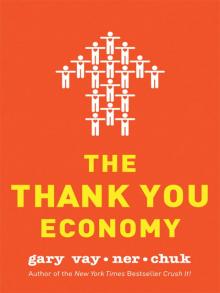 The Thank You Economy
The Thank You Economy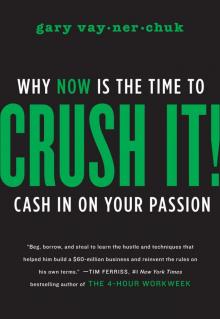 Crush It!
Crush It!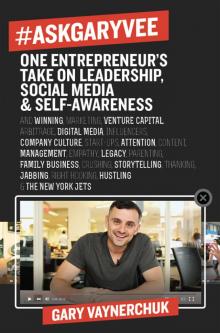 #AskGaryVee
#AskGaryVee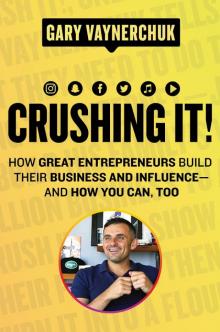 Crushing It! EPB
Crushing It! EPB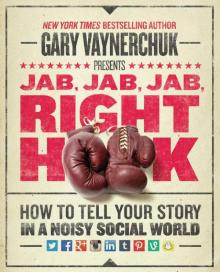 Jab, Jab, Jab, Right Hook
Jab, Jab, Jab, Right Hook